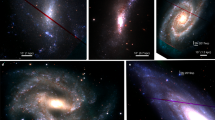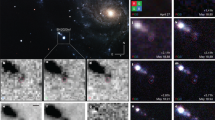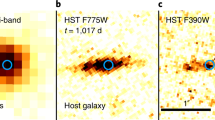Abstract
THE recently observed rise1 in radio flux from SN1987A is earlier than predicted in models of the interaction with the observed line-emitting gas2,3. The observed size of the radio source is roughly consistent with the expected position of the supernova shock wave, which is inside the optically emitting ring. The size is also consistent with the position of the termination shock of the blue supergiant progenitor wind, and the radio increase is attributed to the interaction of the supernova shock with this density jump. The required efficiency of electron acceleration and magnetic field amplification is larger than usually occurs in supernovae and supernova remnants. Possible reasons for the enhanced radio emission are particle acceleration by the weak reflected shock that travels through the interaction region, and the action of the Richtmyer-Meshkov instability near the initial termination-shock density jump. The action of these mechanisms is time-limited; the prediction of this model is that the radio flux should begin to decline within the next year.
This is a preview of subscription content, access via your institution
Access options
Subscribe to this journal
Receive 51 print issues and online access
$199.00 per year
only $3.90 per issue
Buy this article
- Purchase on Springer Link
- Instant access to full article PDF
Prices may be subject to local taxes which are calculated during checkout
Similar content being viewed by others
References
Staveley-Smith, L. et al. Nature (in the press).
Chevalier, R. A. in ESO Workshop on the SN198JA (ed. Danziger, I. J.) 481–494 (European Southern Observatory, Garching, 1987).
Luo, D. & McCray, R. Astrophys. J. 379, 659–662 (1991).
Turtle, A. J. et al. Nature 327, 38–40 (1987).
Chevalier, R. A. & Fransson, C. Nature 328, 44–45 (1987).
Storey, M. C. & Manchester, R. N. Nature 329, 421–423 (1987).
Arnett, W. D. in ESO Workshop on the SN1987A (ed. Danziger, I. J.) 373–381 (European Southern Observatory, Garching, 1987).
Chevalier, R. A. Astrophys. J. 258, 790–797 (1982).
Panagia, N., Gilmozzi, R., Macchetto, F., Adorf, H.-M. & Kirshner, R. P. Astrophys. J. 380, L23–26 (1991).
Weaver, R., McCray, R., Castor, J., Shapiro, P. & Moore, R. Astrophys. J. 218, 377–395 (1977).
Wampler, E. J. et al. Astrophys. J. 362, L13–16 (1990).
Crotts, A. P. S. & Heathcote, S. R. Nature 350, 683–685 (1991).
Silk, J. & Solinger, A. Nature 244, 101–103 (1973).
Blandford, R. & Eichler, D. Phys. Rep. 154, 1–75 (1987).
Richtmyer, R. D. Commun. Pure appl. Math. 8, 297–319 (1960).
Sturtevant, B. in Shock Tubes and Waves (ed. Grönig, H.) 89–100 (VCH, Berlin, 1987).
Pacholczyk, A. G. Radio Astrophysics, 171 (Freeman, San Francisco, 1970).
Serlemitsos, P. J. et al. in Frontiers of X-ray Astronomy (ed. Tanaka, Y. & Koyama, K.) (Universal Academy, Tokyo, in the press).
Author information
Authors and Affiliations
Rights and permissions
About this article
Cite this article
Chevalier, R. A model for the radio brightness of the supernova remnant 1987A. Nature 355, 617–618 (1992). https://doi.org/10.1038/355617a0
Received:
Accepted:
Issue Date:
DOI: https://doi.org/10.1038/355617a0
This article is cited by
-
Diagnostics of the Non-Linear Richtmyer-Meshkov Instability
Astrophysics and Space Science (2007)
-
Non-Linear Dynamics of the Richtmyer–Meshkov Instability in Supernovae
Astrophysics and Space Science (2005)
-
Structure of the radio remnant of supernova 1987A
Nature (1993)
Comments
By submitting a comment you agree to abide by our Terms and Community Guidelines. If you find something abusive or that does not comply with our terms or guidelines please flag it as inappropriate.



